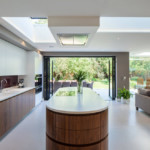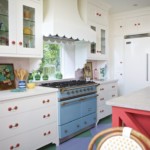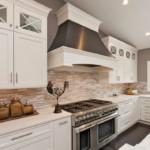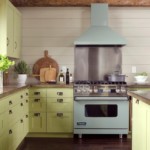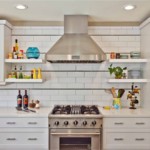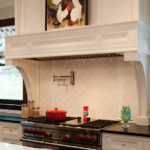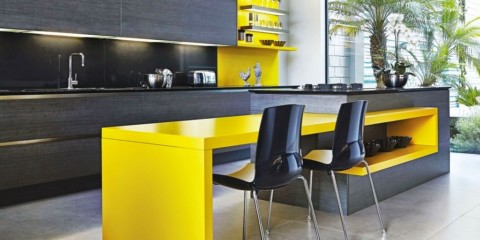 Kitchen
What should be a modern kitchen in 2020
Kitchen
What should be a modern kitchen in 2020
More recently, some 30-40 years ago, when repairing or equipping an apartment, many did not even plan to install a hood. And, of course, they did not puzzle at all which hood for the kitchen would fit into the interior better, how efficiently it would purify the air or work as silently as possible. But today it is rather difficult to imagine a kitchen without it, especially if this room is combined with the living room, and sometimes with the entire space of the apartment.

A properly selected hood perfectly copes with unpleasant odors and combustion products.
The open type is very popular when planning apartments, which requires the installation of powerful and high-quality hoods. Modern housewives are well aware that the hood helps to get rid of many unpleasant odors in the form of burning and others. Also, with the right selection, she will be able to maintain the snow-white ceiling, walls and even the purity of the hanging cabinets.
Flowing or circulating
Content
- Flowing or circulating
- Which hood is suitable for the design of the kitchen - built-in, hanging or domed
- How to calculate the optimal hood power for a kitchen quadrature
- Selection of control type and additional extraction functions
- Video on choosing the right cooker hood
- Photo gallery: hood in the interior of the kitchen
All kitchen hoods, regardless of type and model, carry out the air purification process in two ways:
- The first involves a filtration method: air passes through special filters and the purified one is returned back to the room.
- The second allows, using ventilation shafts, to extract contaminated air into the street using an exhaust hood.
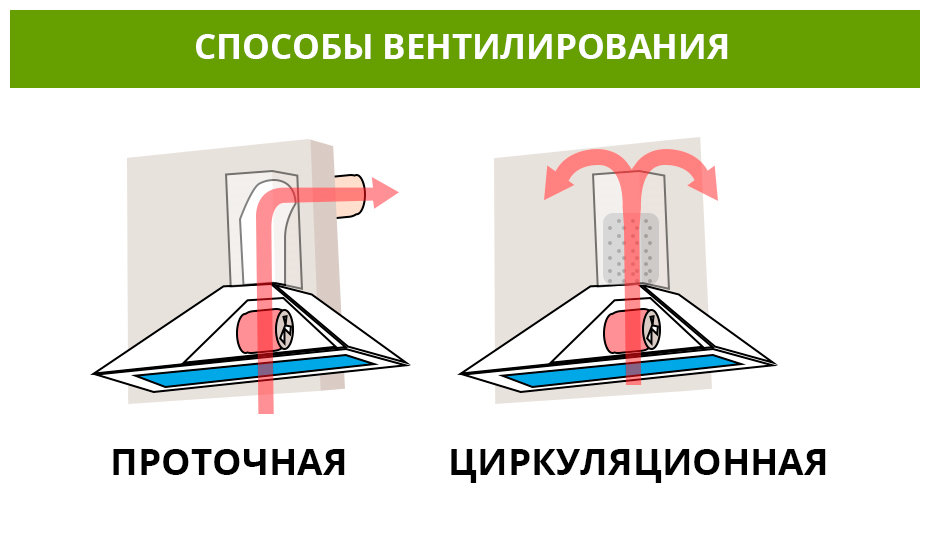
A cooker hood can clean or remove contaminated air

Some models of hoods can work both in recirculation and in direct-flow mode
Modern ventilation devices are made of plastic, aluminum, steel, stainless steel and tempered glass.
The matte surface of aluminum goes well with models of other kitchen appliances. Fingerprints are not visible on such a case, it is easy to wash, it is not subject to corrosion.

The most durable are hoods made of polished or brushed metal.
For a kitchen with a modern design, an extractor hood with a stainless steel case in combination with a special tempered glass is perfect.
Which hood is suitable for the design of the kitchen - built-in, hanging or domed
The first thing you need to pay attention to when deciding which hood is best for the kitchen is the principle of air filtration and shape. All kitchen hoods are divided into 5 types.

Of course, the appearance of the hood should match the interior of the kitchen, but the design of the appliance should not be at the expense of functionality
Embedded
Built-in hood - is the most popular among consumers. Many existing models allow you to find budget options. Possible configurations consist of both powerful hoods and a thin retractable panel for home cooking.

Such models are built into a hanging cabinet or attached to its bottom panel

Built-in hoods are often equipped with a pull-out panel that increases the intake area of polluted air
Some models have a separate air outlet. Such a hood is very relevant for large rooms, it has a fairly low noise level. The disadvantages include the need to allocate space for the headset, as well as the fact that at a price it is more expensive than a suspended option.
Outboard
Hanging hood (there are products flat or inclined). Allows installation on the wall directly above the stove, headset, and also under the kitchen cabinet.

Suspended hoods are the cheapest and easiest to install, but the effectiveness of such models is poor.

Inclined hoods look spectacular, but their efficiency is significantly lower than conventional models
Advantages - affordable price, ease of maintenance, compactness, the ability to install in any selected area, it fits perfectly into the interior of any kitchen.
The disadvantages of this type include the fact that most models use a low-power engine, which allows a small amount of air to pass through. They are not suitable for large rooms, but may be ideal for a small kitchen. Cleaning takes place through acrylic or carbon filters, which need to be changed often, and they are expensive.
Such hoods are distinguished by a high noise level.
Dome
Dome or fireplace hoods - very similar to the hoods of antique fireplaces. But today's models are quite diverse and go well with the modern design style. The main advantage of this type is that through ventilation they remove polluted air from the kitchen to the street. These types of hoods for the kitchen quickly enough can clean the air in large rooms.

Fireplace hoods are more often used in spacious kitchens and above large stoves.

The design of fireplace hoods can be the most varied, you can easily choose the right model for any style of kitchen design - from classic to hi-tech
Pros:
- great for non-standard kitchens - especially corner options;
- a great option for a studio apartment;
- Dome hoods - an excellent solution for summer kitchens in a country house or in the country, as they have great power;
- go well with classics;
- hoods with a wooden decor are perfect for country style, and stainless steel combined with glass trim is a chic option for a high-tech kitchen.
The disadvantages include the complicated installation of the duct, large dimensions and high cost.
Island
Island hood - ideal for a kitchen with an “island".

The purpose of the island hood is clear from the name
The model is mounted on a shelf above the stove in any convenient place.
Island hoods are available in different styles. Previously, they could often be seen in Hollywood movies or expensive restaurants.
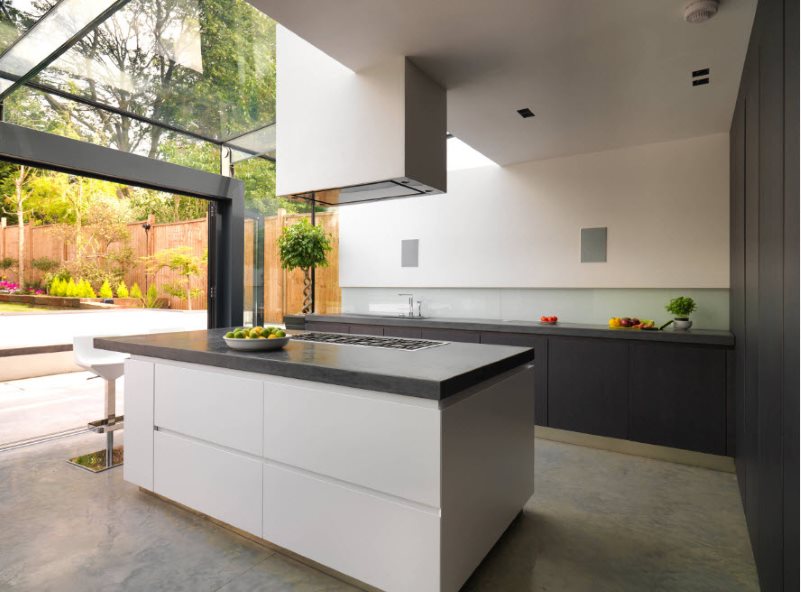
The hood over the island can be made in a wide variety of options - from a rectangular box to an unrealistically bizarre shape

This hood can also be called island due to its location. It represents a laid-on box fixed to the ceiling, and air is discharged through ventilation pipes hidden behind a suspended ceiling
T-shaped
Open-body T-hoods are very stylish and elegant. Mounted to a ceiling or wall. They are different in size, have many design options. For the manufacture of hoods use glass, stainless steel and chromed metals.

T-shaped hoods are not hidden behind the cabinets, but are specially displayed

T-shaped models are more suitable for modern interiors
An open housing is an excellent solution for a loft-style kitchen. On display, it becomes part of the concept of style. In such design solutions, domed air purifiers are used, which are quite massive with a matte or shiny metallic coating.
Modern hoods sometimes resemble lamps with various decorative elements. Inexpensive options are limited to one lamp, in expensive the number reaches five. Various types are used: incandescent, fluorescent, halogen, LED. Some models have built-in motion sensors that adjust the brightness of the light. There are models with focus.

The backlight built into the hood should provide comfortable lighting for the hob
Medium and premium range hoods are equipped with fluorescent, halogen or LED lamps. They are durable, with high brightness and energy efficiency. Incandescent lamps are installed in cheap options, which, unlike the previous ones, are short-lived and energy-consuming.
When deciding on what kind of hood for the kitchen to choose, it is important to pay attention to its noise. Sometimes noise is not only distracting, but annoying. Its level is measured in decibels. The operation of the device is considered very quiet if the noise emitted is comparable to a whisper (35 dB). If the kitchen is isolated from other rooms, then a hood with a noise of 50 dB is absolutely normal. All parameters above 50 dB are considered unacceptable for residential premises. The noise level is affected by the length and diameter, the number of bends of the duct, as well as the presence of a carbon filter.
There are three types of filters used in cooker hoods: acrylic, carbon, aluminum.
The acrylic filter protects the engine from grease and particulate matter. Replace as clogged.

Acrylic filters are disposable, therefore the most inexpensive
Charcoal filters are made from activated, less often chemically treated, coal. It removes odors in recirculation mode. Replace once a year. The operational life of a set of filters is 100-150 hours or six months.

Charcoal filters are designed for extractors operating in recirculation mode
Aluminum filters help clean air from the products of gas and fat combustion. They are divided into two types:
- Disposable - composed of organic fibers. Very impractical and expensive, frequent replacement is necessary. Sold only at service centers.
- Reusable - made of steel or aluminum. Perfectly cleaned and washed with detergents.

The metal filter is a mesh frame that is easy to clean with a cleaning agent at home.
How to calculate the optimal hood power for a kitchen quadrature
Many buyers wondered how to choose a cooker hood, correctly calculating the working power necessary for a particular room.
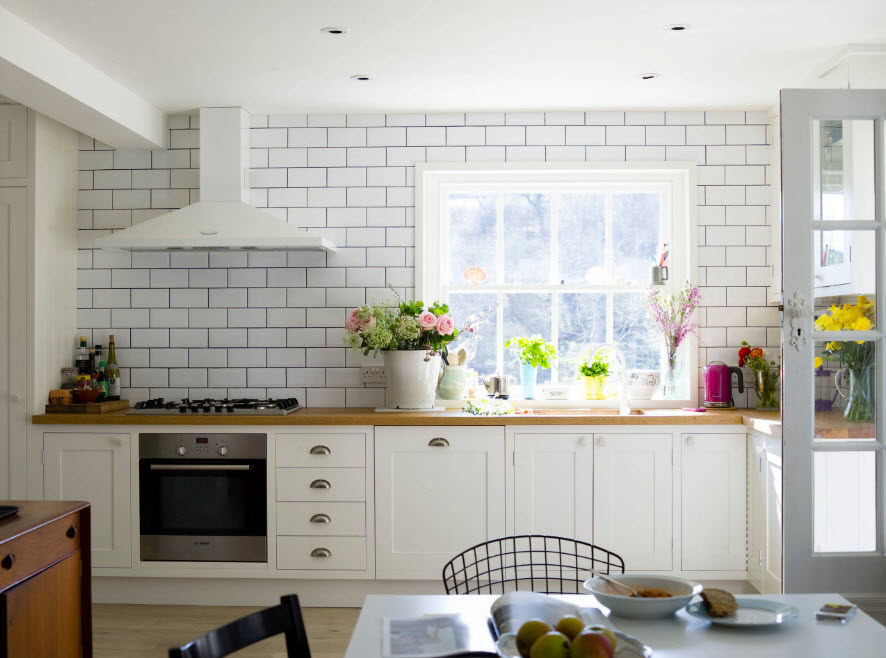
The most important criterion for choosing a hood is its performance - the amount of air that the unit can pass through itself per unit time
Based on the intensity of the fumes during cooking, the updating and purification of indoor air occurs approximately 10-15 times per hour. In the operation manual of the hood, its power is indicated, which allows you to imagine how much air volume (in cubic meters) is drawn in by the hood in the exhaust mode for one hour.

The power of the hood depends on the area of the kitchen
For the correct calculation of power use the formula:
room height (m) × room area (sq. m) × 12 = operating power.
The length of the pipe and the number of bends reduce productivity by 5-10 percent. Also, channels with corrugated walls influence and amplify it. Recirculation mode reduces power by 25 percent.
The more powerful the device, the faster the kitchen room will be cleaned of odors.
Example of calculating the exhaust power:
- room height - 2.7 m
- kitchen area - 15 square meters. mFormula: height 2.7 m × area 15 square meters. m × 12 = power 486 cu m / hour
+ reserve capacity - 10-20% (if the food is burnt)
+ bends - 10%
+ pipe length - 10%Based on the calculations for this kitchen, the best option is a hood with a capacity of 580 cubic meters. m / hour.
It is necessary to take into account the factor that when using additional filters, the resistance to air circulation increases. This suggests that, accordingly, it is necessary to increase the hood power by 30-40 percent.
Depending on the type of stove, the power will also vary. The electric stove does not emit combustion products, but only fumes and fat.For her, the coefficient is slightly above average - not 12, but 15. Hence, the formula Q = S × h × 15.
A gas stove, in addition to the evaporation of water and fat, pollutes the air with harmful substances formed during the combustion of gas. This means that the coefficient will increase to 20. Hence, Q = S × h × 20.
Selection of control type and additional extraction functions
Modern hoods by control methods are divided into:
- controlled by buttons;
- controlled by slider buttons (they are shifted to the side);
- using the touchpad.
Hoods with buttons are the easiest option. They are less prone to breakdowns and easy to manage, but they lack additional features.
Touch control is a display that displays information about the operation of the device (timer, auto power off, lighting, several modes of operation, switching modes. Temperature sensors can change the mode of operation or completely turn off the device at higher rates or smoke, excessive fumes).

The touchpad is much easier to keep clean.
When choosing a hood for the kitchen, you should pay attention to additional options. One of them is a function that continues to operate the device after turning it off for some time (from 5 to 15 minutes). Using this supplement makes it possible to more deeply purify the air in the kitchen.
Additional options also include interval switching of the device. The device can be programmed for self-activation 1-2 times per hour with a duration of intervals of 5-10 minutes, which contributes to continuous cleaning. Even if the kitchen does not prepare food, the room still needs to be periodically ventilated.
Some models have an electronic timer, which can turn itself off after cooking, which will allow you not to monitor the operation of the device.
Almost all models are equipped with light sources. The most popular halogen lamps. They are durable, easy to replace, save electricity. On some hoods, you can adjust the brightness of the lighting in different ranges. There are models that change the focus of lighting: they can create distraction in a certain part, and can only illuminate the hob.

It is worth noting - the more “hoods” in the hood, the higher its cost
There are models of cooker hoods with the option of remote control. More advanced ones are controlled using a smartphone or tablet. Using a special application, you can monitor the operation of the device, change settings, being anywhere. It is also possible to receive reports of increased smoke in the kitchen.
Who needs to what extent all of these additional options will be needed - this is an individual solution. And here is a little advice that will suit everyone.
When choosing a hood, you must pay attention to the dimensions of the device. The larger the device, the greater the coverage of the area from the surface of which contaminated air is drawn in. Which in turn contributes to the creation of the smallest number of air vortices.
As you know, the countertop in the area of the stove or hob is exposed to hot air, which leads to its drying. The larger the hood, the less the countertop will heat up, which means it will last longer.

The width of the hood must be larger than the size of the hob or stove
This review is designed to help determine the most accurate choice of the most suitable device for a particular kitchen, taking into account all the nuances. The hood using the original design can become a highlight of the interior. Modern models will eclipse even the bright facades of kitchen furniture and the exclusive finish of the apron.
Video on choosing the right cooker hood



